
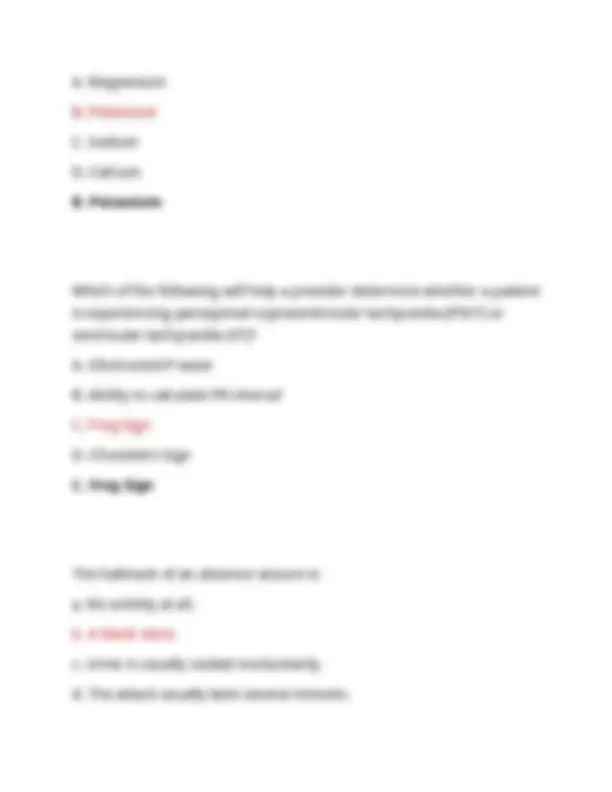
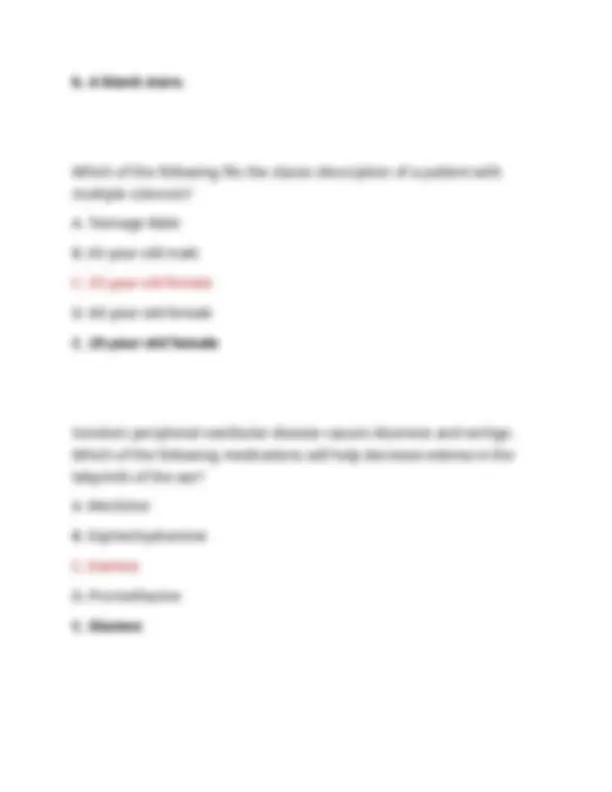
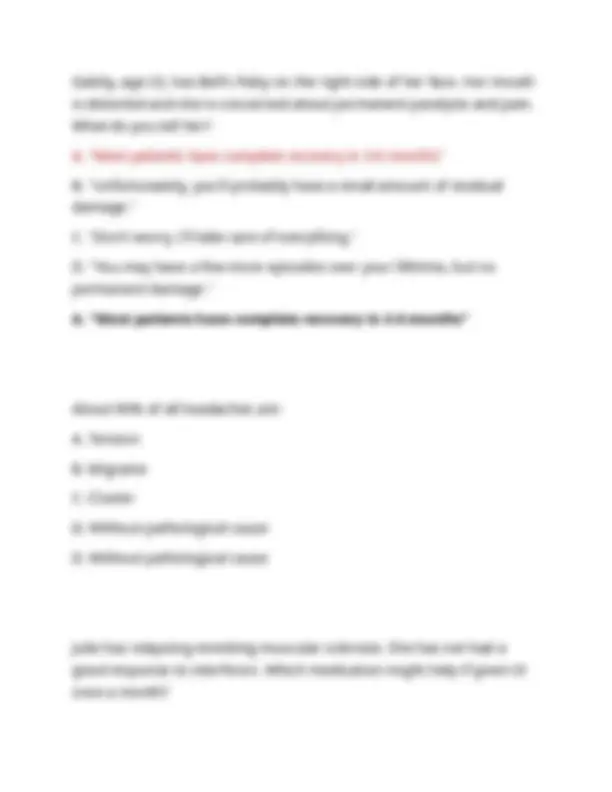
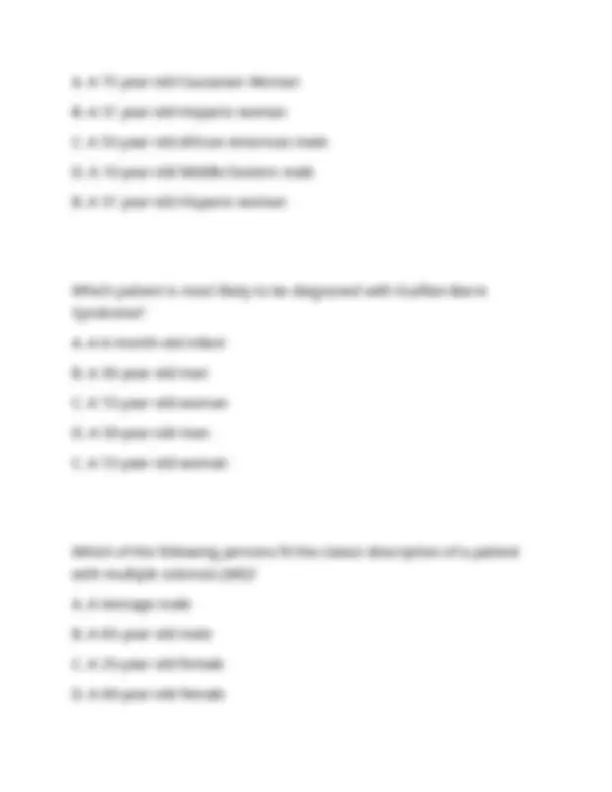
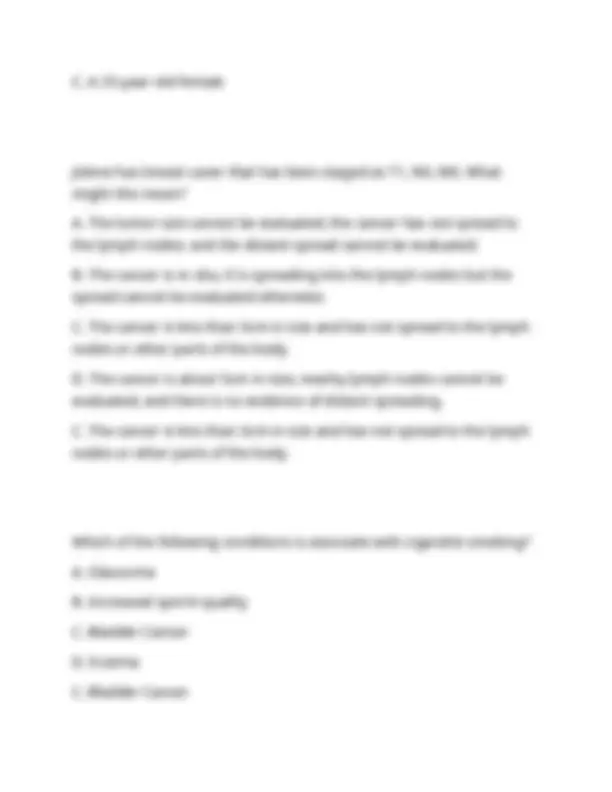
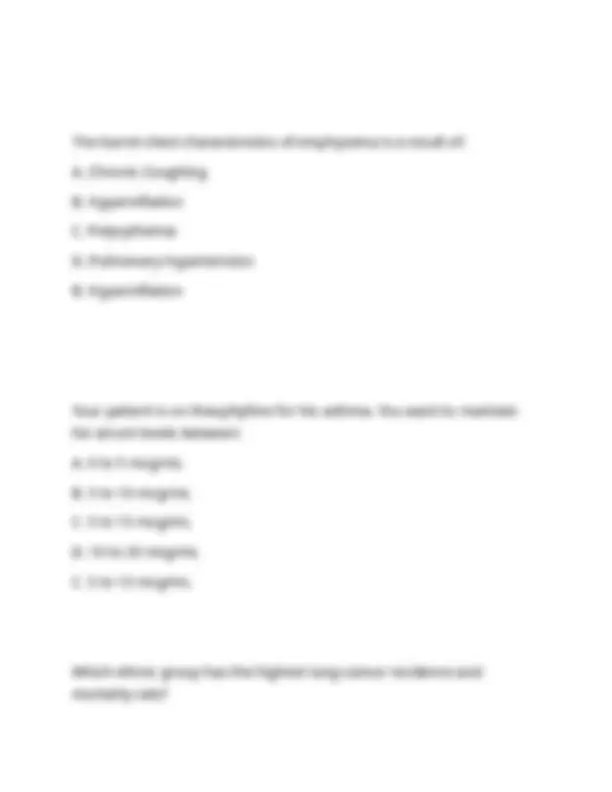
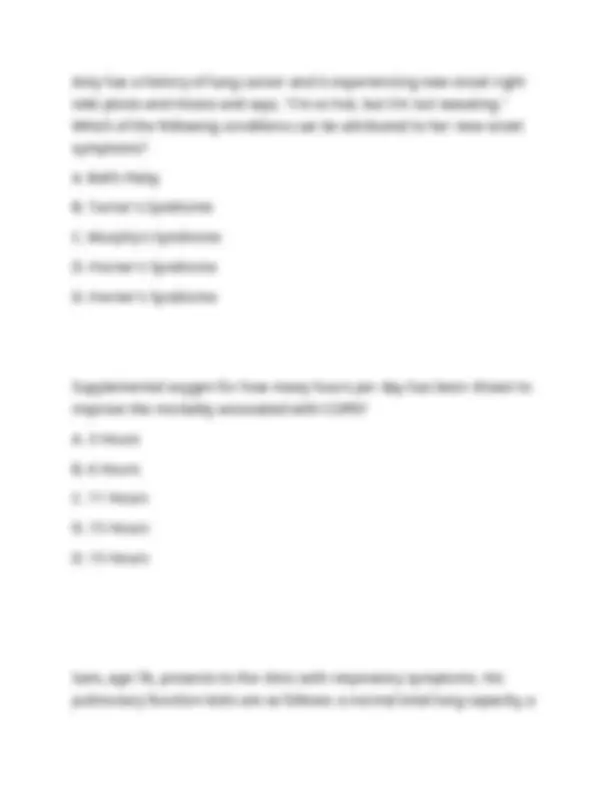
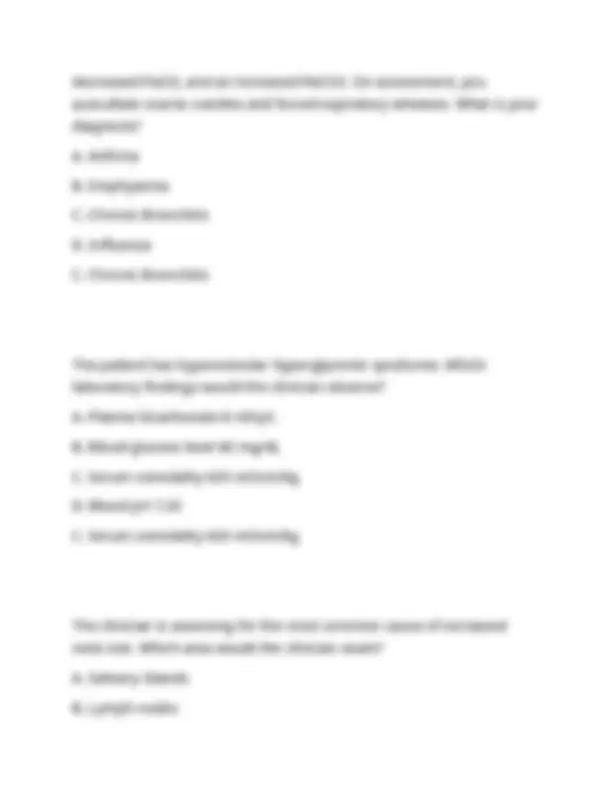
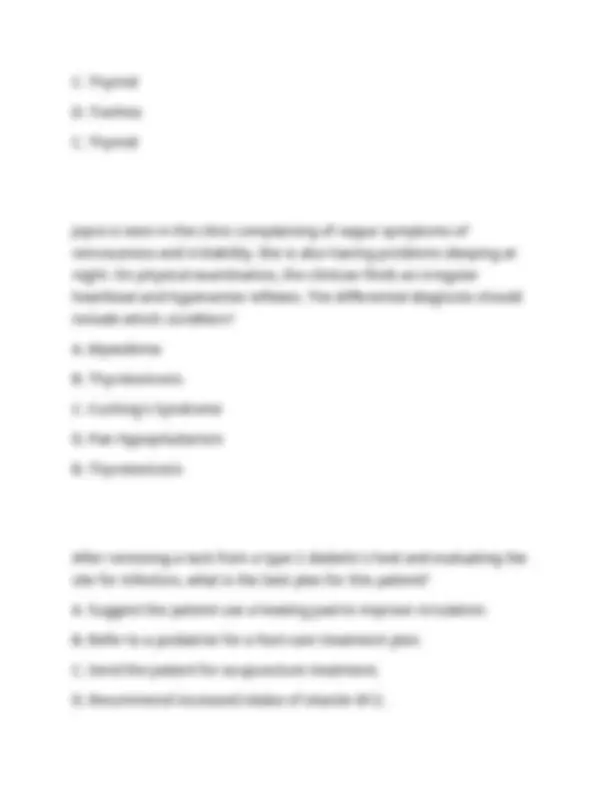
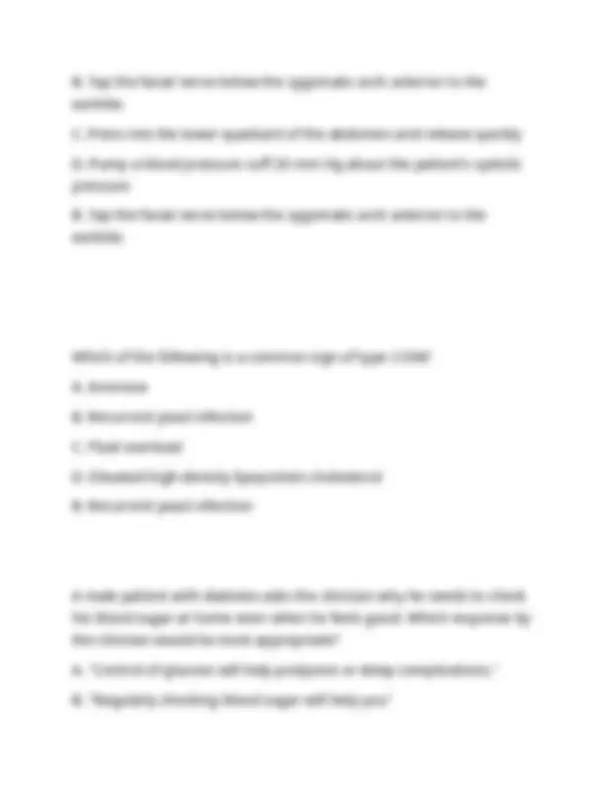
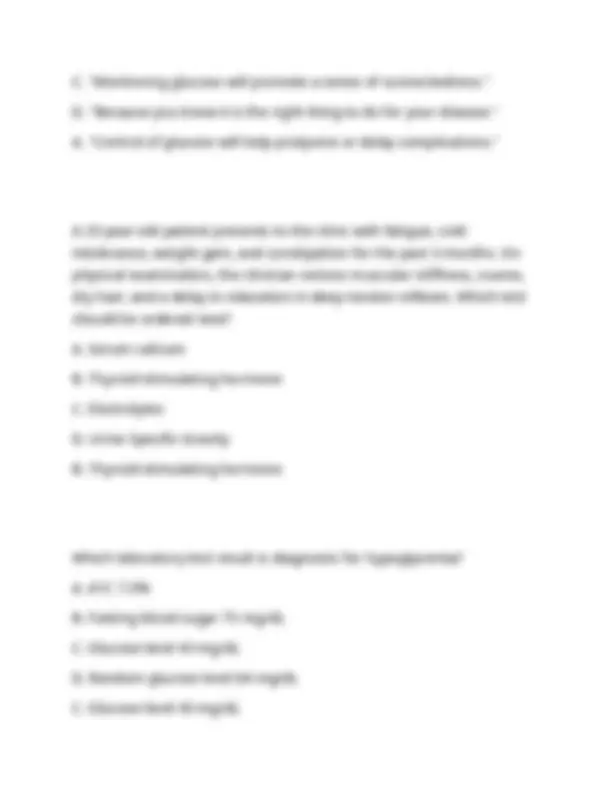
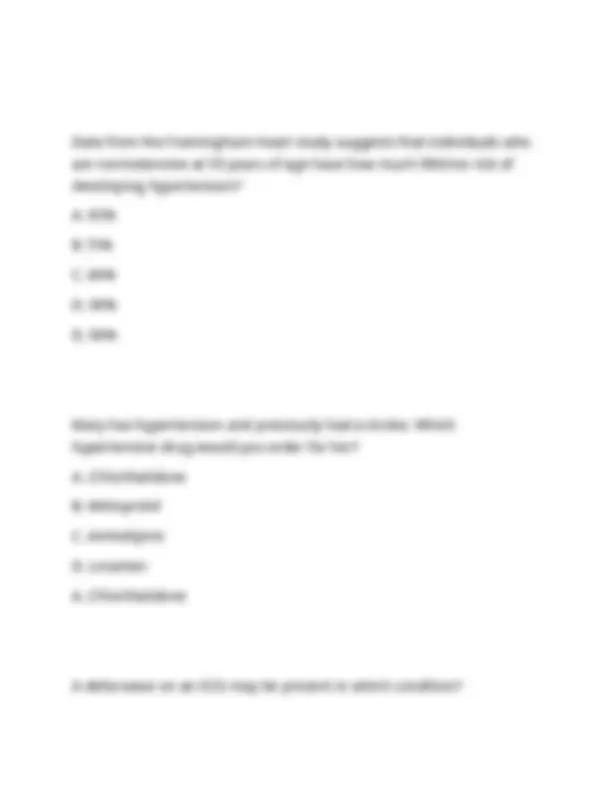
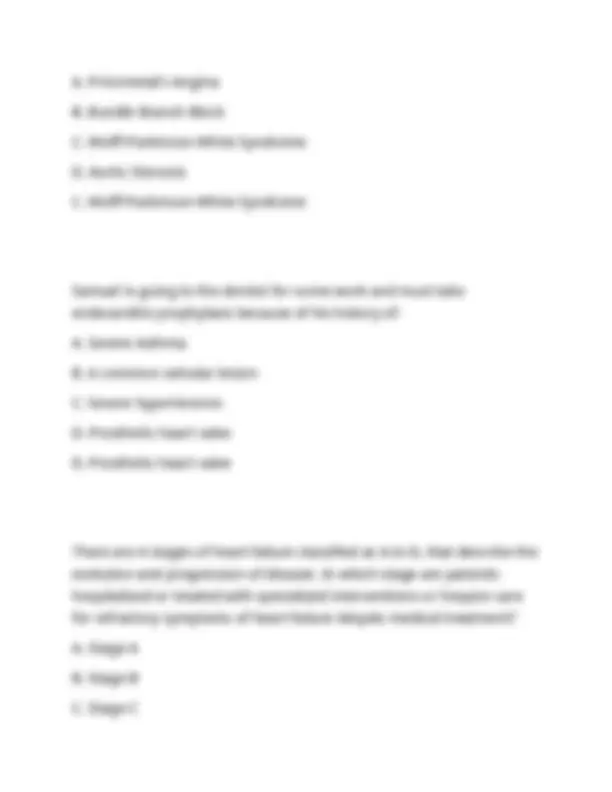
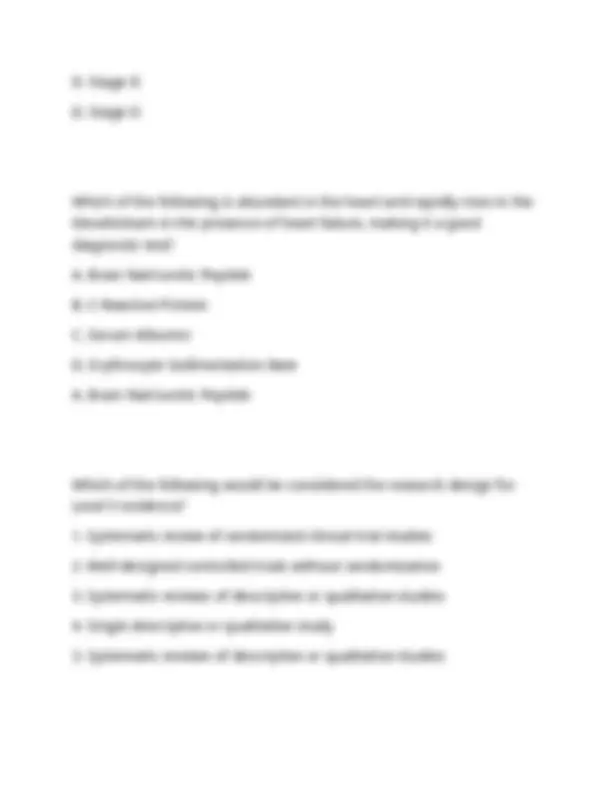
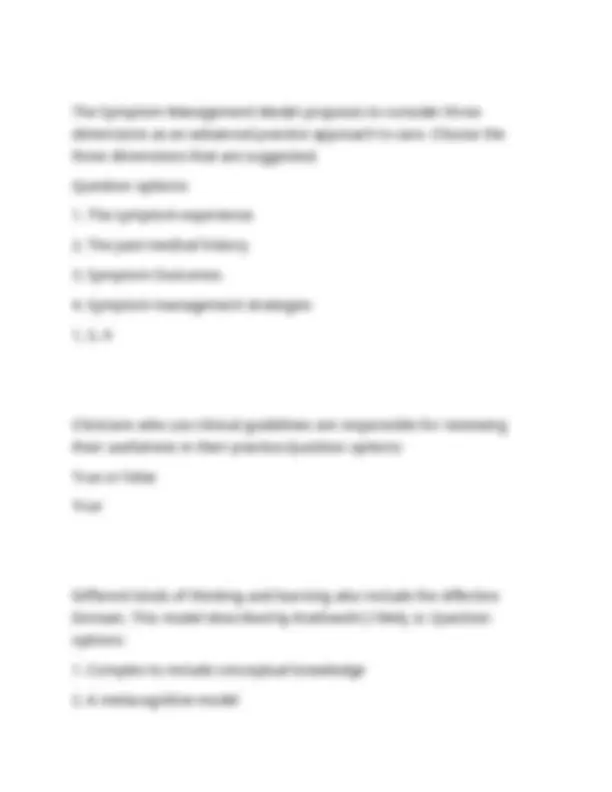
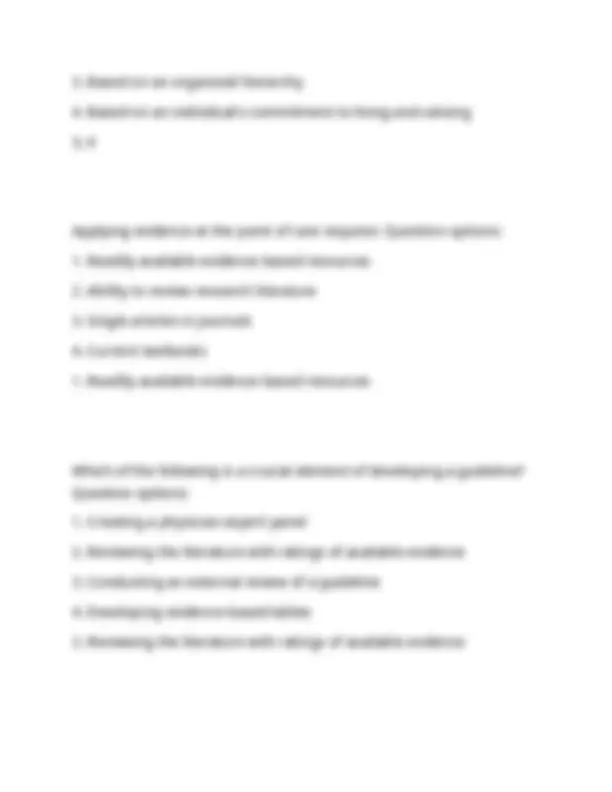
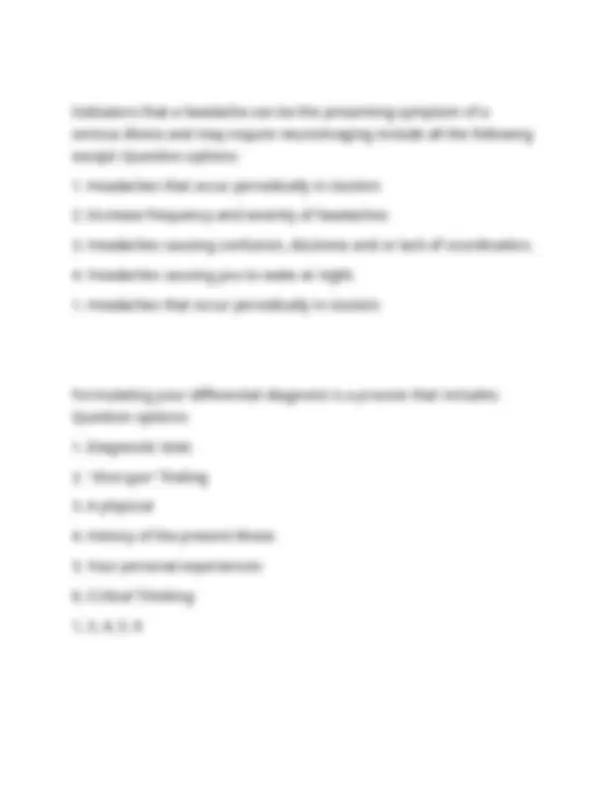
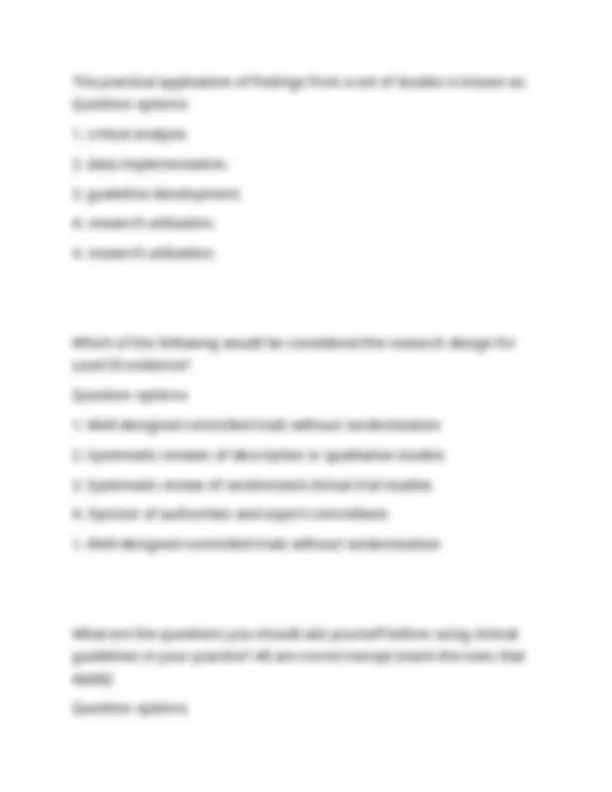
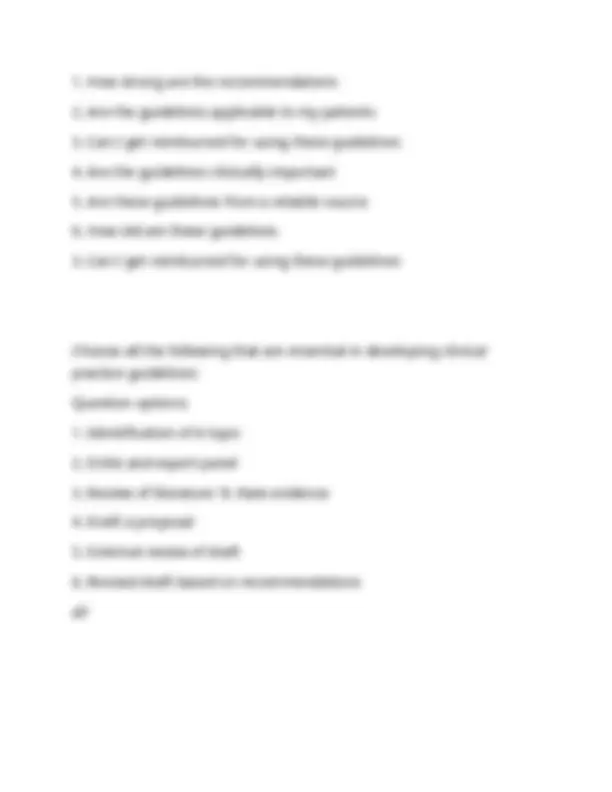
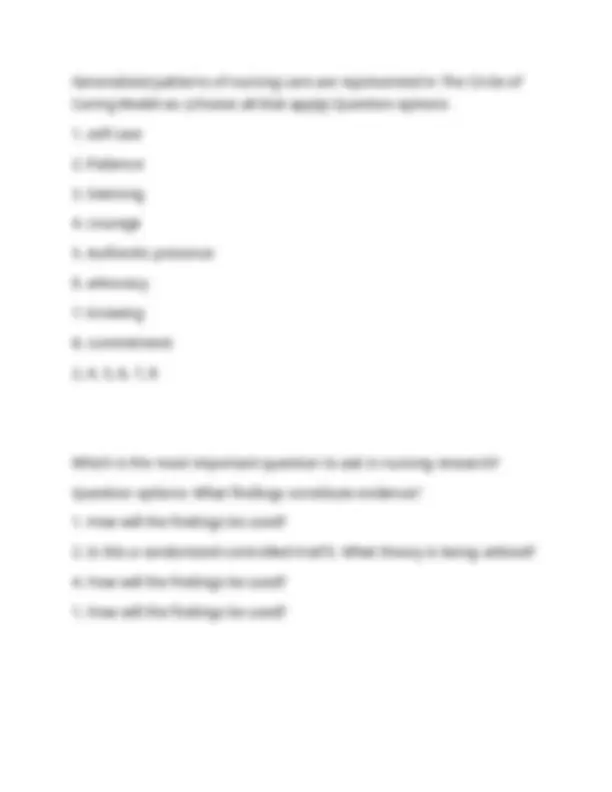
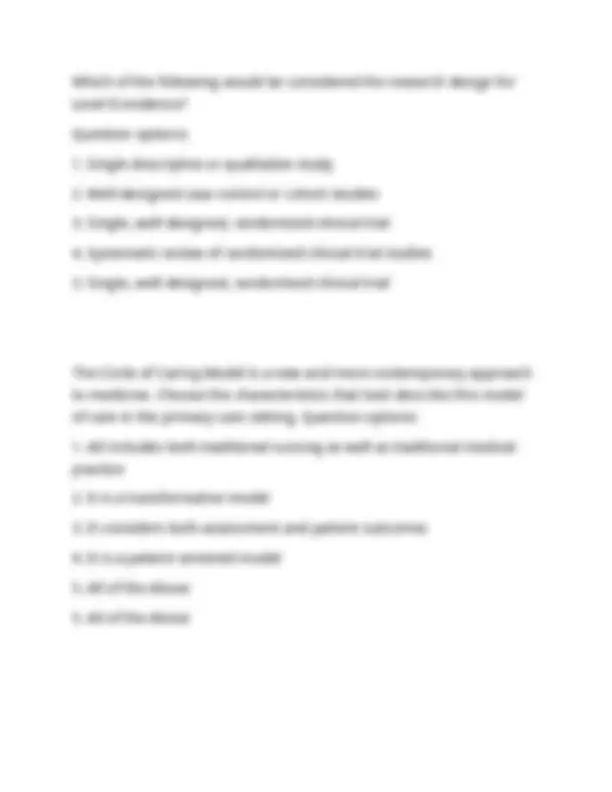
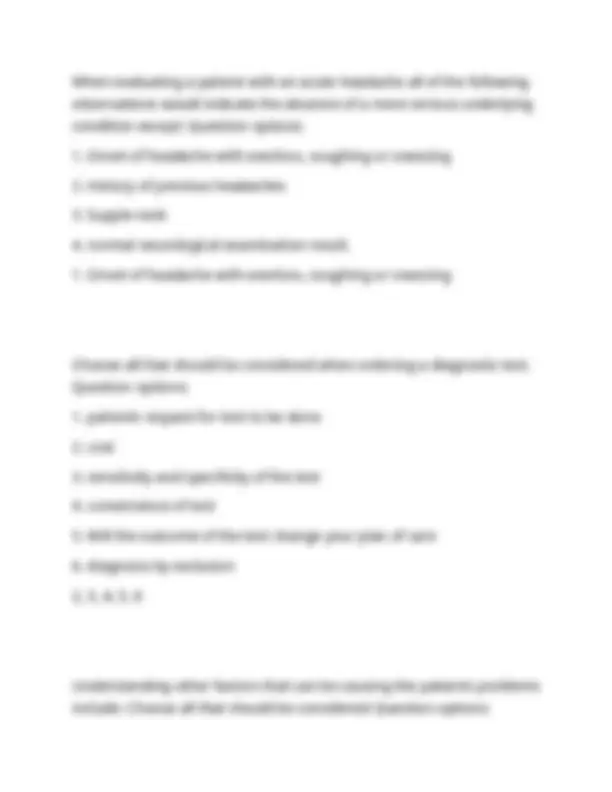
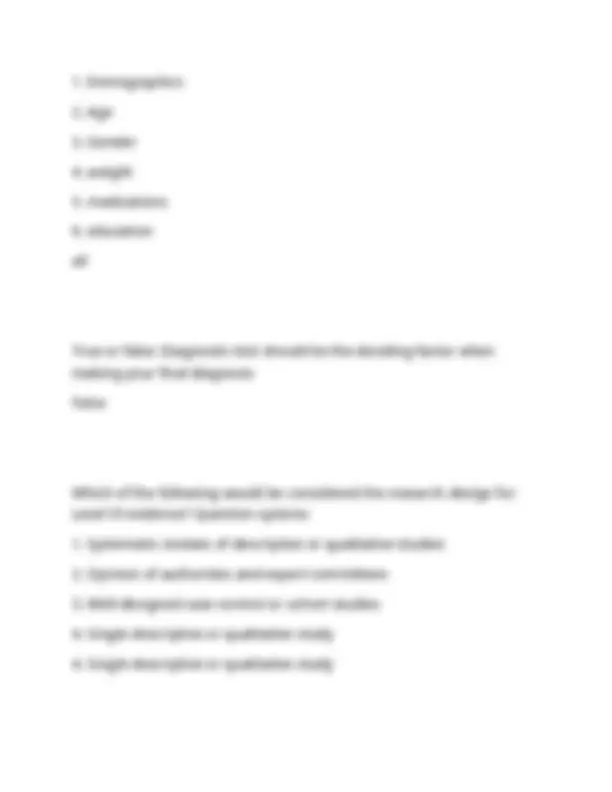
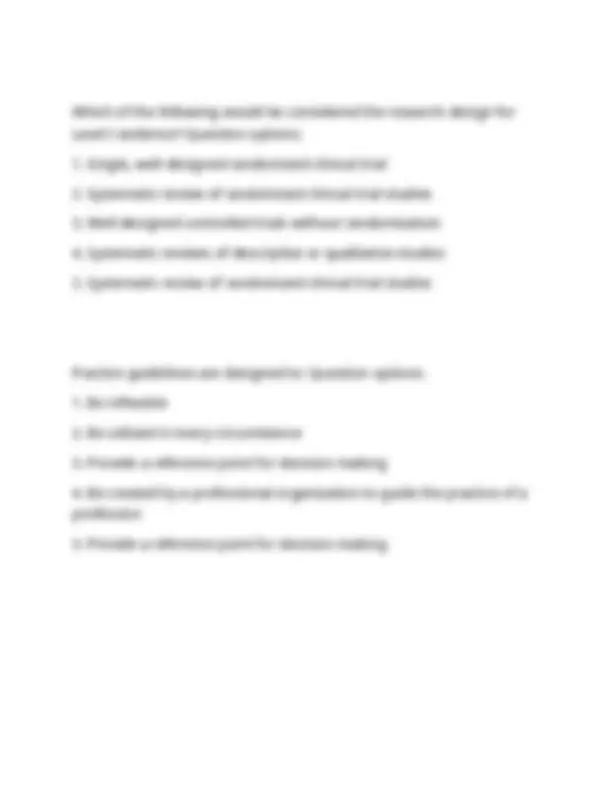


Study with the several resources on Docsity

Earn points by helping other students or get them with a premium plan


Prepare for your exams
Study with the several resources on Docsity

Earn points to download
Earn points by helping other students or get them with a premium plan
Community
Ask the community for help and clear up your study doubts
Discover the best universities in your country according to Docsity users
Free resources
Download our free guides on studying techniques, anxiety management strategies, and thesis advice from Docsity tutors
MN 566 MIDTERM-MN 566 TEST BANK EXAM UPDATE 2025 WITH COMPLETE QS & CORRECT AS |A+ GRADED
Typology: Exams
1 / 32

This page cannot be seen from the preview
Don't miss anything!

























if a pulmonary embolus is suspected, which testing should be performed? A. Ultrasound B. MRI C. V/Q Scan D. D-Dimer C. V/Q Scan Which of the following medications can cause hyperlipidemia? A. High Dose Diuretics B. Exercising 30 minutes every day C. Hyperthyroidism D. Angiotensin II Receptor Blocker A. High Dose Diuretics
In which patient do premature ventricular contractions NOT need to be treated? A. Kelly, a 25-year-old female with an allergy to bee stings B. Mary, a 50-year-old female with a history of untreated anxiety C. Randy, a 45-year old male with history of htn. D. Bill, 65-year-old with history of angina A. Kelly, a 25-year-old female with an allergy to bee stings What is the most common form of heart disease in a patient with atrial fibrillation? A. Hypertension B. Rheumatic Heart Disease C. Angina D. Coronary Artery Disease with heart failure D. Coronary Artery Disease with heart failure What does digitalis compete with at binding sites on the cell membrane?
b. A blank stare. Which of the following fits the classic description of a patient with multiple sclerosis? A. Teenage Male B. 65-year-old male C. 25-year-old female D. 60-year-old female C. 25-year-old female Sondra's peripheral vestibular disease causes dizziness and vertigo. Which of the following medications will help decrease edema in the labyrinth of the ear? A. Meclizine B. Diphenhydramine C. Diamox D. Promethazine C. Diamox
Gabby, age 22, has Bell's Palsy on the right side of her face. Her mouth is distorted and she is concerned about permanent paralysis and pain. What do you tell her? A. "Most patients have complete recovery in 3-6 months" B. "Unfortunately, you'll probably have a small amount of residual damage." C. "Don't worry, I'll take care of everything." D. "You may have a few more episodes over your lifetime, but no permanent damage." A. "Most patients have complete recovery in 3-6 months" About 90% of all headaches are: A. Tension B. Migraine C. Cluster D. Without pathological cause D. Without pathological cause Julie has relapsing-remitting muscular sclerosis. She has not had a good response to interferon. Which medication might help if given IV once a month?
Which of the following should be started promptly if viral encephalitis is suspected? A. Oral amoxicillin B. IV acyclovir C. IV ampicillin D. Oral acyclovir B. IV acyclovir When a patient has a carotid bruit, which of the following should the PCP gather from the patient history? A. History of hemophilia B. History of peripheral vascular occlusive disease C. History of seizure disorder D. History of sickle cell disease B. History of peripheral vascular occlusive disease Which patient is most likely to have myasthenia gravis (MG)?
A. A 75 year-old Caucasian Woman B. A 31 year-old Hispanic woman C. A 55-year-old African American male D. A 10-year-old Middle Eastern male B. A 31 year-old Hispanic woman Which patient is most likely to be diagnosed with Guilllan-Barre Syndrome? A. A 6-month-old infant B. A 30-year-old man C. A 72-year-old woman D. A 50-year-old man C. A 72-year-old woman Which of the following persons fit the classic description of a patient with multiple sclerosis (MS)? A. A teenage male B. A 65-year-old male C. A 25-year-old female D. A 60-year-old female
The barrel-chest characteristics of emphysema is a result of: A. Chronic Coughing B. Hyperinflation C. Polycythemia D. Pulmonary Hypertension B. Hyperinflation Your patient is on theophylline for his asthma. You want to maintain his serum levels between: A. 0 to 5 mcg/mL B. 5 to 10 mcg/mL C. 5 to 15 mcg/mL D. 10 to 20 mcg/mL C. 5 to 15 mcg/mL Which ethnic group has the highest lung-cancer incidence and mortality rate?
A. African American Men B. Scandinavian men and women C. Caucasian women D. Asian Men A. African American Men Marta is taking TB drugs prophylactically. How do you instruct her to take them? A. Take them on an empty stomach to facilitate absorption. B. Take them with aspirin (ASA) to prevent flushing? C. Take them with ibuprofen to prevent a headache. D. Take them with food to prevent nausea. A. Take them on an empty stomach to facilitate absorption. What is the most common cause of CAP? A. Streptococcus pneumoniae B. Klebsiella pneumoniae C. Legionella pneumoniae D. Pseudomonas aeruginosa A. Streptococcus pneumoniae
Amy has a history of lung cancer and is experiencing new-onset right side ptosis and miosis and says, "I'm so hot, but I'm not sweating." Which of the following conditions can be attributed to her new-onset symptoms? A. Bell's Palsy B. Turner's Syndrome C. Murphy's Syndrome D. Horner's Syndrome D. Horner's Syndrome Supplemental oxygen for how many hours per day has been shown to improve the mortality associated with COPD? A. 3 Hours B. 6 Hours C. 11 Hours D. 15 Hours D. 15 Hours Sam, age 78, presents to the clinic with respiratory symptoms. His pulmonary function tests are as follows: a normal total lung capacity, a
decreased PaO2, and an increased PaCO2. On assessment, you auscultate coarse crackles and forced expiratory wheezes. What is your diagnosis? A. Asthma B. Emphysema C. Chronic Bronchitis D. Influenza C. Chronic Bronchitis The patient has hyperosmolar hyperglycemic syndrome. Which laboratory findings would the clinician observe? A. Plasma bicarbonate 8 mEq/L B. Blood glucose level 40 mg/dL C. Serum osmolality 420 mOsm/kg D. Blood pH 7. C. Serum osmolality 420 mOsm/kg The clinician is assessing for the most common cause of increased neck size. Which area would the clinician exam? A. Salivary Glands B. Lymph nodes
B. Refer to a podiatrist for a foot-care treatment plan. Which hydrocortisone dose would the clinician prescribe for a patient with Addison's disease? A. 25 to 50 mg daily B. 0.5 to 0.2 mg daily C. 20 mg in the morning and 10mg in early evening D. 2 to 4mg in the morning and 1 to 2mg in the evening. C. 20 mg in the morning and 10mg in early evening Which instruction should the clinician include in patient teaching regarding management of obesity? A. Occasionally skipping meals is acceptable. B. Try to use nonstick cookware when baking or frying. C. High-intensity physical activity is recommended D. Exercise for about 100 minutes per week B. Try to use nonstick cookware when baking or frying.
Which question should the clinician ask to determine the most frequent cause of diabetic ketoacidosis? A. "How often are you taking your insulin?" B. "Which type of infection have you experienced recently?" C. "What type of diet have you been following?" D. "Is there any reason you don't like taking your medications?" B. "Which type of infection have you experienced recently?" A male patient with type 1 diabetes comes to the clinic complaining of feeling nervous and clammy. He states that he took his insulin this morning but was late for work and did not eat breakfast. Which action should the clinician take first? A. Administer glucagon subcutaneously. B. Have him drink 4 ounces of juice C. Call 911 D. Ask him about his usual eating habits B. Have him drink 4 ounces of juice Which action would the clinician take to elicit Chvostek's sign? A. Check serum level of glucose after drinking a glass of juice.
C. "Monitoring glucose will promote a sense of connectedness." D. "Because you know it is the right thing to do for your disease." A. "Control of glucose will help postpone or delay complications." A 25-year-old patient presents to the clinic with fatigue, cold intolerance, weight gain, and constipation for the past 3 months. On physical examination, the clinician notices muscular stiffness, coarse, dry hair; and a delay in relaxation in deep tendon reflexes. Which test should be ordered next? A. Serum calcium B. Thyroid-stimulating hormone C. Electrolytes D. Urine Specific Gravity B. Thyroid-stimulating hormone Which laboratory test result is diagnostic for hypoglycemia? A. A1C 7.0% B. Fasting blood sugar 75 mg/dL C. Glucose level 43 mg/dL D. Random glucose level 64 mg/dL C. Glucose level 43 mg/dL
Data from the Framingham Heart study suggests that individuals who are normotensive at 55 years of age have how much lifetime risk of developing hypertension? A. 65% B 75% C. 80% D. 90% D. 90% Mary has hypertension and previously had a stroke. Which hypertensive drug would you order for her? A. Chlorthalidone B. Metoprolol C. Amlodipine D. Losartan A. Chlorthalidone A delta wave on an ECG may be present in which condition?